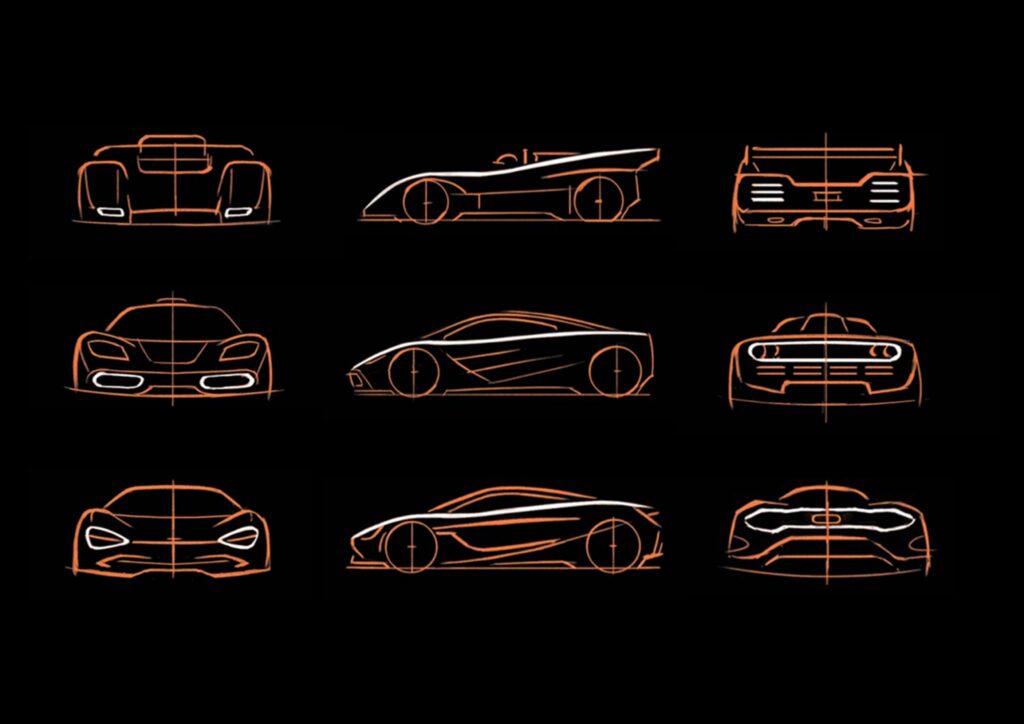
McLaren Automotive today reveals detail of its future design language. Underpinned by 60 years of racing heritage and extraordinary supercars, this next era of McLaren design will be defined by five core principles, upon on which the design fundamentals of McLaren’s next-generation cars will be based.
The visual expression of this Design DNA references McLaren’s innovative and highly successful approach to motorsport engineering, fused with cutting-edge, lightweight supercar design. The new, multi-faceted design ethos paves the way to a new design language appropriate for McLaren vehicles in new segments and with future powertrain technologies.
“Racing is in our DNA, and beauty flows from this relentless pursuit of performance. We are deeply inspired by six decades of McLaren history, but we are not rooted in our past. Our Design DNA will build McLaren into a brand that delivers 60-years of motorsport heritage in incredible lightweight supercars and beyond. A new era, with new vehicles, more product differentiation, and with Performance by Design at the heart of it.”
Tobias Sühlmann, Chief Design Officer, McLaren Automotive
The McLaren Design DNA’s five principles encapsulate Performance by Design. These pillars represent the theory behind McLaren’s new design direction:
EPIC
Epic design concerns the sensory excitement derived from the overall vehicle concept and its appearance:
- Epic and bold vehicle design that triggers an instinctive, emotional reaction
- Direct influence from the aerodynamics and surfacing of Formula 1, Can-Am and GT racers
- Extreme design traits; the McLaren F1 road car’s revolutionary central seating position, the jet-fighter-style sliding canopy of the Solus GT, the quad-exit full-titanium exhaust system of the 765LT
ATHLETIC
Within the epic appearance of a McLaren, Athletic definition is always found, channelling the extraordinary level of performance and agility in each McLaren:
- Tight, muscular bodywork aids overall performance through maximised aerodynamic efficiency, and weight saving
- Efficient packaging of the high-performance powertrain and chassis componentry
- ‘Vacuum formed’ volumes – bodywork free of unnecessary or unwanted mass
FUNCTIONAL
The further we chase performance by design, the more Functional elements appear within the design:
- Feeding directly into the principles of athleticism and ultra-lightweight performance – everything on the car must be there for a reason
- Exposed technical elements where this is the best approach – design and engineering in perfect harmony
- Innovative approaches to advanced aerodynamics, as seen on Ultimate vehicles like the McLaren Senna and P1™, and cooling, as seen on the new Artura Spider and the double-skinned doors of the McLaren 750S
FOCUSED
A Focused feel is as integral to the design as the epic appearance and super-lightweight, aerodynamic engineering that delivers performance:
- Performance-driven ergonomics, the ultimate driving position, unparalleled visibility
- The perfect blend of analogue and digital information streams
- Everything the driver touches, sees and feels aids in the delivery of maximising the driving experience and vehicle performance
INTELLIGENT
Extracting the most performance from the car requires an Intelligent approach to design:
- Vehicles engineered, designed and finished with innovative, lightweight materials
- Developing these materials for new uses, making them lighter, stronger, more durable, more sustainable, and expanding their roles
- Deeper, more seamless integration of design elements that augment and enhance the driving experience
The Design DNA manifests into a set of key Design Signatures inspired by McLaren’s rich history in motorsport and dedication to cutting-edge high-performance engineering.
The front view design signature is defined by two main, symmetrical elements with horizontal orientation and a low nose. Inspiration comes from legendary McLaren racers, such as the side air intakes of hugely successful Formula 1 cars such as the McLaren MP4/4. This design element also features on the legendary McLaren F1 and its LM and GTR variants, with its large air intakes placed on the front bumper, directly beneath the headlights, and the distinctive ‘eye-socket’ headlights with integrated intakes used on the McLaren 750S.
Defining the Design Signature of future McLaren vehicles when viewed side on will be the Performance Line. This iconic shoulder line is inspired directly by the profiles of iconic McLaren Can-Am racers, the McLaren F1, and the McLaren P1™, and lends itself to athletic, forward leaning proportions, with short front and rear overhangs.
The rear view of the design signature is defined by an open back end – a design trait introduced by the F1 and widely interpreted on all modern McLaren supercars – bringing with it the functionality of greater heat dissipation. Straight line graphics and horizontal orientation of design elements create a greater sense of width and lower vehicle height, for squat, racing car-like proportions.
Building on McLaren’s driver focused design ethos, future McLaren models will feature a ‘wrap-around’ cockpit bringing purity of purpose and clarity of vision inspired by McLaren’s racing DNA, enabling the driver to focus fully on driving performance. But the interior space won’t feel claustrophobic or compromised. It will feel spacious and comfortable through intelligent design, such as the integration of concave surfaces, and a horizon-like view forward.
Leave a Reply
You must be logged in to post a comment.